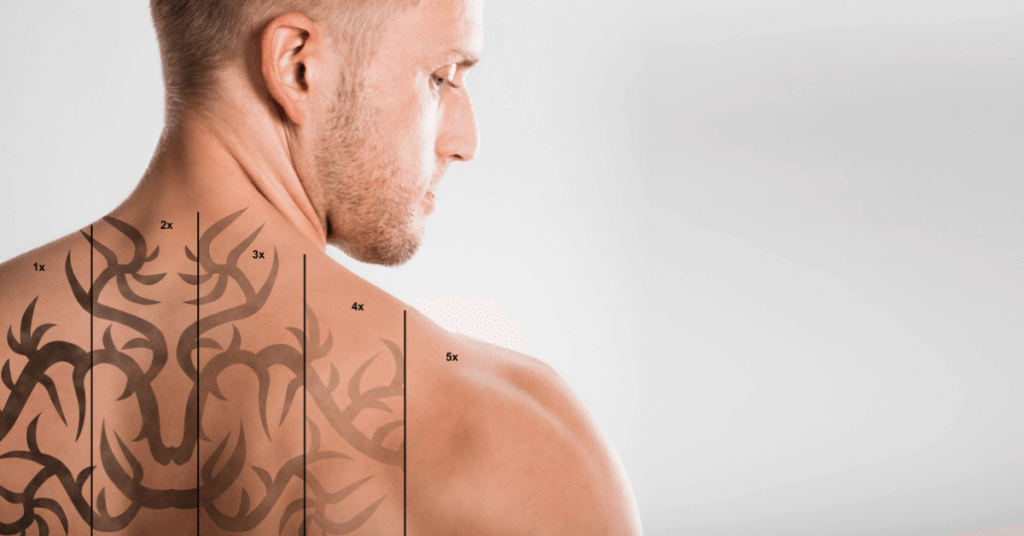This is an excellent advantage because while tattoos serve as a form of self-expression, cherished memories can sometimes turn into nightmares, and what seemed like a great idea at the time of tattooing may become a regrettable choice years later.
Let’s talk about it.
Tattoos Explained
If you are reading this article, you probably have a tattoo and are fully aware of what a tattoo is. However, do you know why they were deemed permanent in previous decades?
This is due to how the ink is deposited into the second layer of your skin, called the dermis. Traditional tattooing involves needles puncturing the skin rapidly, depositing ink into this second layer. The dermis is stable and does not shed cells like your outer layer (the epidermis) does. This stability causes ink particles to remain trapped within the dermis, visible through the outer layer of skin, for many years.
Let Us Look At Some Statistics
A recent UK study revealed that a quarter of the British population has tattoos, and one in nine of this group has visible tattoos (i.e., on their head, face, neck, forearms, wrists, or hands).
Estimates also suggest that around 30% of the global population has at least one tattoo. However, despite the popularity of tattoos today, tattoo removal is equally in demand, driven by factors such as changes in personal preferences, career considerations, or dissatisfaction with existing tattoos.
About 11% of Americans have considered or have already had tattoo removal. Roughly one in nine people in the UK have also undergone tattoo removal treatment, and according to new research, 38% of those with tattoos have considered a tattoo removal procedure.
Different Tattoo Removal Procedures
Several types of tattoo removal procedures are available today. The most common method is laser tattoo removal, which uses high-intensity laser beams to break down tattoo ink particles in the skin.
Other methods include intense pulsed light (IPL) therapy, surgical excision (physically cutting out the tattooed skin and stitching the surrounding skin together), dermabrasion, salabrasion, and topical creams. However, their effectiveness varies and often does not completely remove tattoos.
Each method’s suitability depends on factors such as tattoo size, location, ink colours, and individual skin characteristics, with laser removal considered the most effective and widely used option.
How Laser Tattoo Removal Works
Laser tattoo removal involves using specialised lasers to break down the ink particles in your skin. The process works by directing highly-concentrated beams of light into the tattooed area. These pulses of light are absorbed by the tattoo ink, causing it to fragment into smaller particles.
Different wavelengths of laser light are used depending on the colours of the tattoo ink. Darker colours, such as black and blue, absorb specific wavelengths, while lighter colours, like green and yellow, require different wavelengths for effective removal.
Benefits Of Laser Tattoo Removal
- Effective Results: Laser removal can significantly lighten or completely remove tattoos, depending on factors like ink colour and skin type.
- Non-Invasive: Unlike surgical methods, laser tattoo removal is non-invasive, meaning it does not require cutting into your skin.
- Minimal Scarring: When performed by a skilled professional, laser removal minimises the risk of scarring compared to other methods.
- Customisable Treatment: The treatment plan can be tailored to address specific tattoo characteristics and patient preferences.
What To Take Into Consideration Before Treatment
While laser tattoo removal is generally safe and effective, there are factors to consider before undergoing treatment:
- Skin Type: Individuals with darker skin tones may be more prone to pigmentation changes.
- Health Conditions: Certain medical conditions or medications may affect treatment eligibility.
- Cost & Time: Multiple sessions are typically required for complete removal, and costs vary based on the tattoo’s size and complexity. Removing a small butterfly on your ankle will be much cheaper and faster than removing a large lion tattooed on your back.
- Patient Expectations: Complete removal may not always be possible, and some residual pigmentation could remain.
If you are currently living with a tattoo that is bothering you, please do not hesitate to reach out so we can discuss whether laser tattoo removal is a suitable option for you.
Closing Thoughts
With advancements in technology and techniques, you no longer have to live with imagery and wording on your body you do not want.
Laser tattoo removal can effectively erase ink regrets, allowing you to embrace a new chapter in your skin’s story. It is a reliable and non-surgical option that provides a path toward skin transformation, allowing you to move forward with a clearer canvas.














